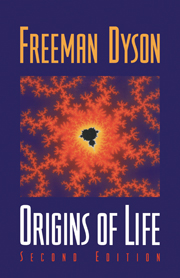CHAPTER THREE - A Toy Model
Published online by Cambridge University Press: 06 August 2009
Summary
THE MEANING OF METABOLISM
This chapter describes my own attempt to understand the Oparin theory of the origin of life. The essential feature of the Oparin theory is that it has life beginning with metabolism rather than with precise replication. In this chapter I shall use the phrase “Oparin theory” to include both the original Oparin theory and the later versions proposed by Wächtershäuser and others. The Oparin theory as Oparin proposed it made no attempt to be quantitative. I am trying to place the theory within a framework of strict mathematics so that its consequences can be calculated. The essential difficulty arises because metabolism is a vague and ill-defined concept. There is no such difficulty with the concept of replication. Replication means exactly what it says. To replicate a molecule means to copy it, either exactly or with a stated margin of error. Starting from this well-defined concept, Manfred Eigen was able to formulate his theory of the origin of life, which is in fact a theory of the origin of replication, as a system of equations that can be solved with a computer. Eigen's equations describe the evolution with time of populations of molecules subject to nonlinear laws of replication. When we try to formulate in a similarly exact fashion the theory of Oparin, which is a theory of the origin of metabolism, we run immediately into the problem of defining what we mean by metabolism.
- Type
- Chapter
- Information
- Origins of Life , pp. 48 - 71Publisher: Cambridge University PressPrint publication year: 1999



